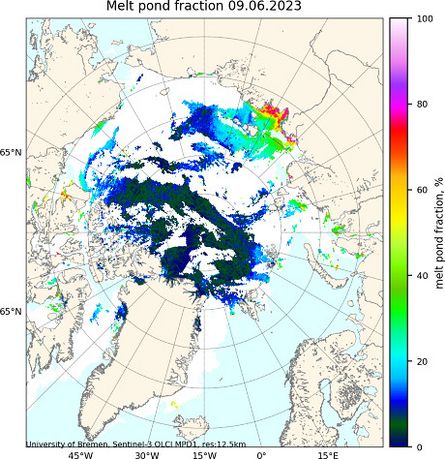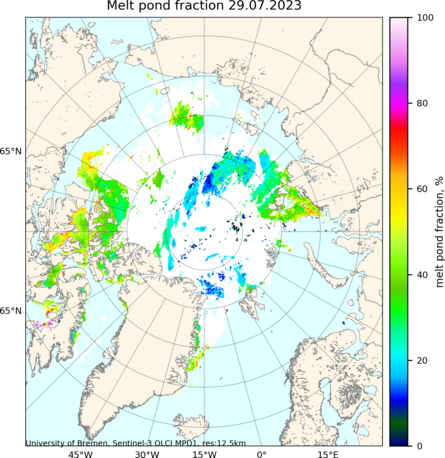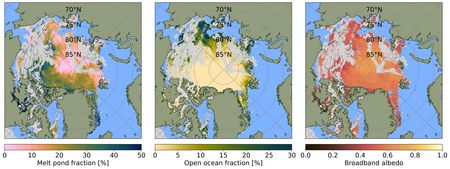
Melt Pond Detector 2 (MPD2) Data from Sentinel-3
The Melt Pond Detector 2 (MPD2) algorithm, is an improved version of the MPD algorithm described below. MPD2 retrieves melt pond, sea ice, and open ocean fractions as well as surface albedo from Sentinel-3 OLCI data. The novelty is the third, open ocean, surface type class that is accounted for. The separation of the third surface type is enabled by using prior information on the surface type constituents and physical characteristics like the temperature history, as introduced by Niehaus et al., 2024 (https://doi.org/10.5194/tc-18-933-2024). By this, the tendency of overestimating melt pond fractions is significantly reduced. The data is provided as 1 day and 7 day averages.
MELT POND FRACTION AND SEA ICE ALBEDO USING MERIS AND OLCI DATA
Melt ponds on the Arctic sea ice affect the albedo, mass balance and heat balance of the ice by translating the increase of air temperature into drastic and rapid surface type changes. They introduce a positive feedback within the sea ice albedo feedback loop, thus facilitating further ice melt. In the context of changing Arctic climate, knowledge of melt pond fraction, its spatial distribution and the length of the melt season is required to reflect and predict the role of the sea ice cover in the radiative balance of the region.
The temporal dynamics of melt can be subdivided into four stages (Eicken et al., 2002):
- Melt onset: widespread ponding and lateral melt water flow.
- Drainage: both the surface albedo and melt pond fraction decrease due to removal of snow cover and due to pond drainage.
- Melt evolution: the meltwater penetrates deeper into the ice, the pond coverage continues to evolve and melt pond fraction to grow.
- Freeze-up: surface albedo is still affected by the now over-frozen ponds.
The melt pond fraction during each of these stages, their duration and the date of their onset/end are specific to sea ice type and can provide a lot of information on the state of the sea ice and its change. A satellite retrieval of the melt pond fraction and albedo allows to observe the melt evolution and how it is reflected in the surface optical properties throughout the whole Arctic summer.
The available dataset consists of daily averages of the melt pond fraction, spectral albedo at 400nm, 500nm, 600nm, 700nm, 800nm and 900nm, and broadband albedo over the ice-covered Arctic Ocean produced using the MPD retrieval (Zege et al., 2015). The data is gridded on a 12.5km polar stereographic grid. The broadband sea ice albedo has been calculated according to Pohl et al., 2020. The melt pond area fraction is retrieved via inversion of a forward model (Malinka et al., 2016). The MPD retrieval has been validated against field, ship-based and airborne measurements (Istomina et al., 2015a). Case studies and weekly trends are presented by Istomina et al. (2015b).
NEW VERSION v1.7 is available! Versions v1.0 and v1.5 are obsolete and should no longer be used.
Available versions:
MERIS and OLCI MPF v1.7 (improvement of v1.5, generalised dataset suitable for long-term studies): Published by Istomina et al. (2023). Temporal coverage: May-September 2002-2011 and 2017-2023. Instrument: MERIS and OLCI. Cloud screening: as presented by Istomina et al. 2023.
MERIS MPF v1.5 (improvement of MERIS MPF v1.0): Published by Istomina et al. (2020). Temporal coverage: May-September 2002-2011. Instrument: MERIS (Medium Resolution Imaging Spectrometer) swath Level 1b data. Cloud screening: as presented by Istomina et al. (2020).
OLCI MPF v1.5 (same as MERIS MPF v1.5 but for OLCI on Sentinel-3): Published by Istomina et al., AGU 2020. Temporal coverage: 2017 - 2020 and ongoing. Instrument: OLCI (Ocean and Land Colour Instrument ) onboard Sentinel-3. Cloud screening: synergy OLCI/SLSTR.
MERIS MPF v1.0 (obsolete): Published by Istomina et al. (2015a). Temporal coverage: May-September 2002-2011. Instrument: MERIS (Medium Resolution Imaging Spectrometer) swath Level 1b data. Cloud screening: as presented by Zege et al. (2015).
 |
 |
Data Archive
All data can be found in the Data Archive. To quickly browse the dataset, please have a look at the Data Browser.
Citation
OLCI and MERIS V1.7: When referring to the data, please include EU project SPICES, grant number 640161, and DFG project REASSESS, DFG SPP 1158, grant number 424326801, in the acknowledgements. The dataset has been presented in the following publication: Istomina, L., Niehaus, H., and Spreen, G.: Updated Arctic melt pond fraction dataset and trends 2002–2023 using ENVISAT and Sentinel-3 remote sensing data, The Cryosphere Discuss. [preprint], doi.org/10.5194/tc-2023-142, in review, 2023.
MERIS MPF V1.5: When referring to the data, please include EU project SPICES and DFG project REASSESS, DFG SPP 1158, grant number 424326801, in the acknowledgements. The dataset has been presented in the following publication: Istomina, L., Marks, H., Huntemann, M., Heygster, G., and Spreen, G.: Improved cloud detection over sea ice and snow during Arctic summer using MERIS data, Atmos. Meas. Tech., 13, 6459–6472, doi:10.5194/amt-13-6459-2020, 2020.
OLCI MPF V1.5: When referring to the data, please include the following acknowledgement: "This research has been supported by the DFG SPP 1158, grant number 424326801". The dataset have been presented by Istomina, L., H. Marks, H. Niehaus, M. Huntemann, G. Heygster, G. Spreen: Retrieval of sea ice surface melt using OLCI data onboard Sentinel-3, AGU Fall Meeting 2020.
MERIS MPF V1.0: When referring to the data, please include the EU Porject SIDARUS in the acknowledgements and cite the following publication: Istomina, L., Heygster, G., Huntemann, M., Schwarz, P., Birnbaum, G., Scharien, R., Polashenski, C., Perovich, D., Zege, E., Malinka, A., Prikhach, A., and Katsev, I.: Melt pond fraction and spectral sea ice albedo retrieval from MERIS data – Part 1: Validation against in situ, aerial, and ship cruise data, The Cryosphere, 9, 1551-1566, doi:10.5194/tc-9-1551-2015, 2015.
Contact
For more details on the melt pond fraction and albedo data, please contact Larysa Istomina and Gunnar Spreen.
References
Niehaus, H., L. Istomina, M. Nicolaus, R. Tao, A. Malinka, E. Zege, & G. Spreen (2024). Melt pond fractions on Arctic summer sea ice retrieved from Sentinel-3 satellite data with a constrained physical forward model. The Cryosphere, 18, 933–956. doi:10.5194/tc-18-933-2024
Istomina, L., Niehaus, H., and Spreen, G.: Updated Arctic melt pond fraction dataset and trends 2002–2023 using ENVISAT and Sentinel-3 remote sensing data, The Cryosphere Discuss. [preprint], doi.org/10.5194/tc-2023-142, in review, 2023.
Niehaus, H., G. Spreen, G. Birnbaum, L. Istomina, E. Jäkel, F. Linhardt, N. Neckel, M. Nicolaus, T. Sperzel, M. A. Webster, N. C. Wright, N. Fuchs, & R. Tao (2023). Sea Ice Melt Pond Fraction Derived From Sentinel-2 Data: Along the MOSAiC Drift and Arctic-Wide. Geophys. Res. Lett., 50(5), e2022GL102102. doi:10.1029/2022GL102102
Istomina, L., Marks, H., Huntemann, M., Heygster, G., and Spreen, G.: Improved cloud detection over sea ice and snow during Arctic summer using MERIS data, Atmos. Meas. Tech., 13, 6459–6472, doi:10.5194/amt-13-6459-2020, 2020.
Pohl, C., Istomina, L., Tietsche, S., Jäkel, E., Stapf, J., Spreen, G., and Heygster, G.: Broadband albedo of Arctic sea ice from MERIS optical data, The Cryosphere, 14, 165–182, doi:10.5194/tc-14-165-2020, 2020.
Malinka, A., E. Zege, L. Istomina, G. Heygster, G. Spreen, D. Perovich, & C. Polashenski (2018). Reflective properties of melt ponds on sea ice. The Cryosphere, 12, 1921–1937. doi:10.5194/tc-12-1921-2018
Malinka, A., Zege, E., Heygster, G., Istomina, L.: Reflective properties of white sea ice and snow. The Cryosphere, 10, 2541-2557, doi:10.5194/tc-10-2541-2016, 2016.
Istomina, L., Heygster, G., Huntemann, M., Schwarz, P., Birnbaum, G., Scharien, R., Polashenski, C., Perovich, D., Zege, E., Malinka, A., Prikhach, A., and Katsev, I.: Melt pond fraction and spectral sea ice albedo retrieval from MERIS data – Part 1: Validation against in situ, aerial, and ship cruise data, The Cryosphere, 9, 1551-1566, doi:10.5194/tc-9-1551-2015, 2015a.
Istomina, L., Heygster, G., Huntemann, M., Marks, H., Melsheimer, C., Zege, E., Malinka, A., Prikhach, A., and Katsev, I.: Melt pond fraction and spectral sea ice albedo retrieval from MERIS data – Part 2: Case studies and trends of sea ice albedo and melt ponds in the Arctic for years 2002–2011, The Cryosphere, 9, 1567-1578, doi:10.5194/tc-9-1567-2015, 2015b.
Zege, E., Malinka, A., Katsev, I., Prikhach, A., Heygster, G., Istomina, L., Birnbaum, G., and Schwarz, P.: Algorithm to retrieve the melt pond fraction and the spectral albedo of Arctic summer ice from satellite optical data, Remote Sens. Environ., 163, 153-164, doi:10.1016/j.rse.2015.03.012, 2015.



 Start
Start